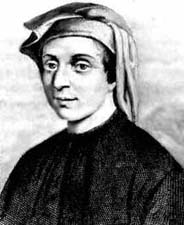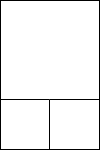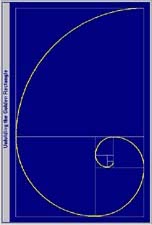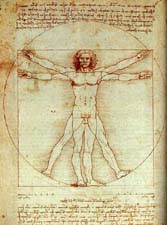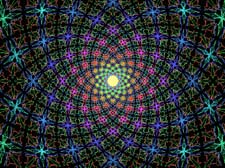2.26.2004
Art Studio 122 Visual Design through Algorithms
Lindsay Orndorff
Investigation of Fibonacci
Orgin of Fibonacci
The Fibonacci Series named by French mathematician Edouard
Lucas, was developed by the mathematician Leonardo Pisano , also known
as Fibonacci.
Responsible for contributing to the European math system with Hindu-Arabic
numbers, he discovered the Golden Section or Phi. A book written by Fibonacci,
Liber abaci, led to the discovery of the series spurred by the following
question:
A certain man put a pair of rabbits in a place surrounded on all sides by a wall. How many pairs of rabbits can be produced from that pair in a year if it is supposed that every month each pair begets a new pair which from the second month on becomes productive?
The sequence that resulted was what we know today to be the Fibonacci Series:
1, 1, 2, 3, 5, 8, 13, 21, 34, 55...
This sequence can be calculated by adding one number in the series to its preceding number in the series. Thus 0+1 = 1, 1+1 = 2, 1+2 = 3 and so on. Another way of looking at this series is through this formula:
F1 = 1, F2 = 1, F(n) = F(n-1) + F(n-2) [when n > 2]
Fibonacci and the Golden Rectangle
One of the most important mathematical values related to the Fibonacci
Series is the value of Phi
. By taking the ratio of two sequential numbers in the Fibonacci Series,
you can get a value that gets closer and closer to the value of Phi. Phi
is also important with the concept of constructing the Golden Rectangle.
To construct the golden rectangle, you begin with two squares whose sides are equal to 1.
From that point, you make a square whose side is now equal to the sum of the preceding squares. The squares are constructed in the same way that the Fibonacci Series is derived.
Once you have constructed the Golden Rectangle, a spiral can be drawn using the squares as points on the spiral. If a line is drawn from the center of the spiral out toward one of the square sides, you can see that the distance of the spiral increases by Phi for each quarter turn of the spiral. This spiral can be seen in nature in the form of snail shells and nautilus shells.
Fibonacci in Art and Architecture
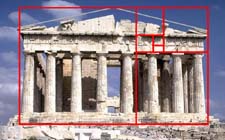
Although Fibonacci is responsible for the discovery of the Fibonacci Series, the Golden ratio was used long before it was ever defined mathematically. On civilization that used the Golden Ratio was the Greeks. The mathematician Pythagoras „was especially interested in the golden section, and proved that it was the basis for the proportions of the human figure. He showed that the human body is built with each part in a definite golden proportion to all the other parts.š (Golden Section) Because of his initial discoveries, a large portion of Greek art and architecture was based around Golden Rectangles and other related Golden Ratios.
The Parthenon is one example where the Golden Rectangle can be distinguished in the architecture. The building as a whole fits into a Golden Rectangle, while other parts of the building are represented by rectangles too.
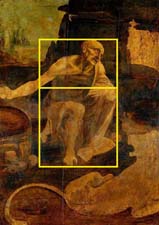
After the Greek empire fell, many of the studies of the Golden ratio disappeared. However, during the Renaissance, there was a new born interest in mathematics and art. One artist at the heart of this investigation was Leonardo da Vinci. Like Pythagoras, he was also interested in human proportion and how the Golden Ratio was related. He believed that if you drew a line through the naval that it would separate the body in a 8:5 ratio, or by Phi.
His interest of the Golden Ratio can been seen in many of his works. For example, in the work Saint Jerome, the body is confined to a Golden rectangle very much making it seem as though it was intentional. The Mona Lisa is another example where the Golden Rectangle is used in composition.
Artists today still use the Golden Ratio in much of their work.
Architect Le Corbusier was known for outting Golden Rectangles into much of his work. The UN building, which he worked on, is composed of a large Golden Rectangle. Many of his other works were centered around the Golden Rectangle. He wrote The Modulor which was based around his mathematical exploration of arcitecture, and how he arrived at the Golden Ratio.
Billie Ruth Sudduth, a former psychologist, used her knowledge in mathematics to produce a series of baskets based off of the Fibonacci Series. Her baskets are now apart of the Renwick Gallery of the Smithsonian Institution, the American Craft Museum in New York, and the Mint Museum of Craft and Design in Charlotte, North Carolina.
Kees van Prooijen produces art that is based on a variation of the Fibonacci series. Instead of adding two sequential numbers together, he adds three sequential numbers. He then uses this ration to porduce his works of art.
Ned May produces works based off of the Fibonacci Spiral. He uses the program Visual Basic to produce an array of psychedelic images.
Ron
Knott
Golden
Section in Art and Architecture
Florence
and Human Proportion
United
Nations
Leonardo da Vinci
Le Corbusier
